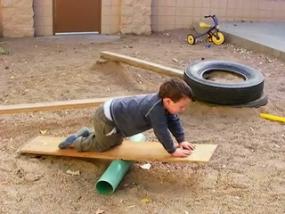Playground Physics

When children play outdoors, they are doing more than developing their gross motor skills and self-confidence. They are also experimenting with the physics of their bodies on swings, seesaws, jungle gyms, and in this case, a tilting board on a green pipe.
Brayden, age four, experiments with a board that tilts, depending on which side holds more of his weight. Here are possible thoughts that Brayden has as he experiments with the balance board. Note the amazing amount of thinking that is involved in these two minutes of play.
The following possible thoughts are arranged in the order that they occur in the video clip. See if you can find the behavior that matches Brayden’s possible thoughts, or let us know if you have different interpretations, or how you might redesign the balance board.
1. I am more stable if I crawl on all fours up the ramp.
2. If I am blocked because the board on my end is up, I can push it down. I know it will go down because I just saw it go up.
3. If I don’t want to lose my balance by pressing the board down with my foot, I can enter the ramp on the other side where the board is already down.
4. If I want to make the board change its tilt, the best place to stand is in the middle with one foot on each side of the green tube.
5. To make the board change its tilt, I need to slowly transfer weight from my downhill foot to my uphill foot.
6. I now know the feeling of the board, so now I will press on the uphill side of the board instead of walking to the other side.
7. Once I make the uphill side go down, I can reverse the tilt by transferring weight back to my uphill foot, the one that was downhill before the tilt.
8. Actually, I don’t have to walk up the ramp to play my game. I can enter directly at the middle of the board from the ground. This strategy eliminates the probability that I will lose my balance as I walk up the incline.
9. Instead of alternating upside to downside back and forth, I will try to make the board pause more in a horizontal position with my weight distributed equally on both sides of the green pipe.
10. To make the board pause in the middle I need to press down with my uphill foot, but at the same time I should not shift weight too quickly from my downhill foot.
11. Perhaps if I put my uphill foot further uphill I will have more control over the abruptness of the tilt.
12. If I can’t make the board pause in a balanced position, let me quickly test the back and forth limits of down, up, down, up.
13. I need to replace the board that fell off such that the green pipe is under the middle of the board.
14. Yes, when I put my uphill foot further uphill, the board seems to tilt more slowly.
15. I have tried and had a good time, but I think I will stop.
Not only does Brayden’s behavior reveal his theories about playground physics, but also these theories themselves are based on a sensori-motor logic described most clearly by Jean Piaget. For example, Brayden’s transition, around #10, indicates a new type of thinking called renversibilite’. A child’s thoughts are said to have renversibilite’ when the child understands that one action can serve two opposing functions. In #10 Brayden understands that he must press down with his uphill foot, to make the board go down, but he must also hold back a bit so that the board will not go down too far. This type of two-way thinking is a milestone in cognitive development and is fundamental to understanding higher forms of logic later in life.
Keywords: Fours, Child-Object, Cause/Effect, Invention, Movement
Length of stand alone master video clip: 2 minutes 19 seconds
